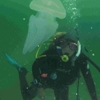General Description
Transparent, clear to blue balloon float with a single prominent, blue tentacle underneath. Float about 6 cm across, tentacles up to 1 m long.
Biology
These animals float on the surface with their tentacles hanging below in the water. The float can be orientated in one of two ways so that individuals are blown to the left (left-sailing) or to the right (right-sailing). This ensures that they do not all get blown in the same direction.
Habitat
Floating on the surface, may drift near shore due to tides and wind.
Open water
Distribution guide
Worldwide.
Species Group
Jellyfishes and allies › Jellyfishes
Depth
Water Column
Max Size
6 cm
Diet
Carnivore
Harmful
Painful sting that requires medical advice. Specimens washed ashore are still able to sting.
Commercial Species
No
Global Dispersal
Recorded in Australia
Identify
Conservation Status
- DSE Advisory List : Not listed
- EPBC Act 1999 : Not listed
- IUCN Red List : Not listed






